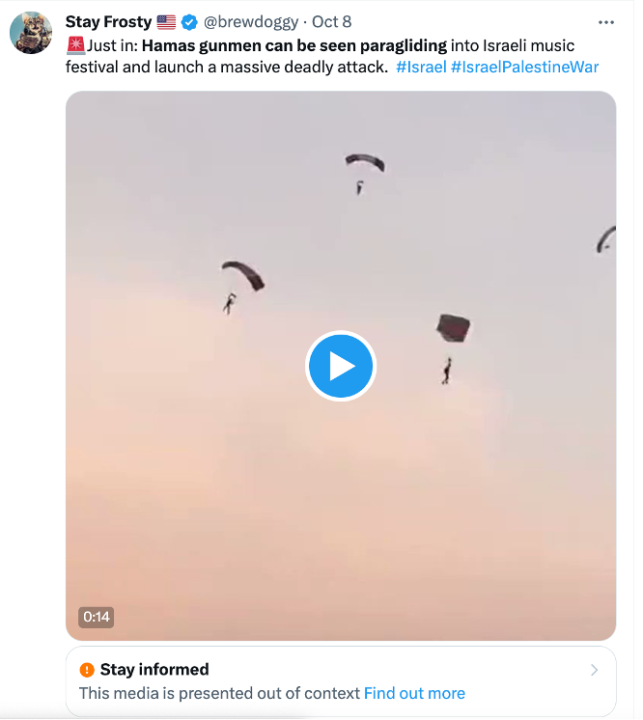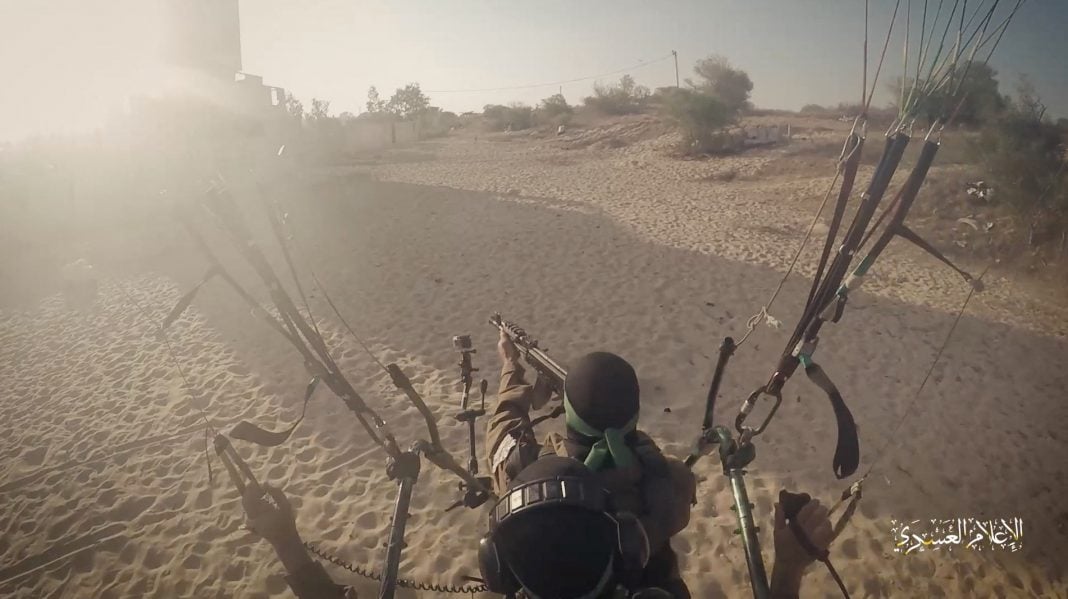By Dina Sadek, Layla Mashkoor, for DFRLab
An endless flood of false, misleading, and unverified information risks inflaming the conflict.
In the wake of renewed warfare between Hamas and Israel, false and unverified information, old footage, and graphic material have flooded social media platforms, in some cases amplified by journalists and media outlets. Misinformation is spreading alongside posts containing violent rhetoric, whether in the form of encouraging further bloodshed by Hamas or calling for collective punishment against Palestinians.
An already tense conflict is being inflamed by an information environment rife with false information, hate speech, and incitements of violence. The desire for up-to-date information is far outpacing the availability of verifiable information, leading many to buy into false or unsubstantiated reports that are difficult, if not impossible, to substantiate in real time.
The significant escalation of the Israel-Hamas conflict comes amid rising tensions and increased incidents of violence. Following an attack on a synagogue in Jerusalem that killed seven in January 2023, Israeli Prime Minister Benjamin Netanyahu promised a “strong, swift and precise” response. Later that month, Gaza militants fired rockets into Israel in response to Israeli troops killing nine Palestinians. This year also witnessed a deadly escalation between Israeli security forces and Palestinian armed groups in Gaza, increased raids in the West Bank, and deployment of Israeli forces to Jenin. In August, Israeli government minister Amichai Eliyahu called for the annexation of West Bank “as quickly as possible,” describing the Green Line separating Israel and the Palestinian territories “fictitious.”
The DFRLab analyzed social media platforms popular in the region, including Telegram and X (formerly Twitter), where much of the content about the conflict is actively circulating.
Telegram use skyrockets among pro-Hamas channels as Israel solidifies its Twitter/X presence
The early days of the current conflict have witnessed an increased reliance on Telegram as a source of information, particularly on the Hamas side. Both Hamas and Palestinian Islamic Jihad have relied on Telegram as their primary means of communication, broadcasting videos documenting their violent incursion into Israeli territory and the capturing of hostages. Given that the content is extremely graphic and revolves around calls to violence, Telegram’s lack of robust moderation serves militant factions seeking to spread propaganda at scale.
The Telegram channel for Hamas’s military wing, Al-Qassam Brigades, has experienced significant growth since the start of the conflict, according to the Telegram analytics tool TGStat. During the one-year period prior to their attack on October 7, the brigade’s channel modestly grew from approximately 182,000 to 205,000 subscribers, with each post averaging around 25,000 views. On October 7, the channel gained more than 135,000 new subscribers, surpassing 336,000. At the time of writing on October 12, the channel had tripled in size from pre-war levels, surpassing 619,000 subscribers, while its posts averaged more than 239,000 views per post, nearly a tenfold increase.

The Hamas-aligned Gaza Now media channel also garnered significant growth. After remaining relatively steady with around 350,000 subscribers, it nearly doubled in size within the first 24 hours of the conflict, eventually surpassing more than 1.1 million subscribers as of October 12. Similarly, the average number of views per individual Gaza Now posts rose from around 42,000 views to more than 432,000 views per post, a ten-fold increase.

Entities supportive of Hamas have also seen their Telegram presence grow dramatically. Most notably, the official channel for Hezbollah was previously in decline, having reached a peak of nearly 90,000 subscribers in July 2023 before dropping to fewer than 57,000 subscribers as of October 6. Since then, it has surpassed its prior peak, surpassing 112,000 subscribers on October 12.

In contrast to Hamas, Israel continues to embrace X/Twitter, given the site’s popularity in the country, as well as its global reach. Accounts affiliated with the Israeli government and military have experienced growth since the Hamas attack on October 7, though not on the scale seen on the Hamas side on Telegram.
For example, @Israel, the public diplomacy account of Israel’s foreign ministry, experienced a jump from approximately 938,000 followers on October 6 to 1.2 million on October 12, according to Twitter analytics tool Social Blade, while this Israeli Defense Forces account @IDF grew from 1.5 million to more than 2 million followers during the same period. Similarly, @IsraeliPM, the account of the prime minister’s office, rose from 994,000 followers to nearly 1.1 million, while the personal account of Israeli Prime Minister Benjamin Netanyahu increased from 2.27 million followers to 2.54 million.
Among Israeli media outlets, Twitter accounts publishing in English generally grew at a more significant rate than their Hebrew counterparts, as there is a much larger potential global audience of English speakers than those who can understand Hebrew. For example, English-language news services, @haaretzcom increased from 408,000 to 451,000 subscribers, while @Jerusalem_Post grew from 587,000 to 663,000 followers. In contrast, Hebrew-language outlets such as @haaretz gained fewer than two thousand new followers to reach 210,000, while @YediotAhronot rose approximately 1,400 followers to reach just under 75,000, and @MaarivOnline increased fewer than 500 followers to reach 58,000. @n12news, which tweets in Hebrew but maintains an online English-language live-stream service, grew from 606,000 to 630,000 subscribers.
False or unverified information
Due to the surprise nature of the attack catching Israel off guard, multiple waves of speculation and misinformation spread online alongside accurate reports, feeding into the hunger for news about how the attack was organized and executed.
The geopolitical implications of Hamas’s attack were an immediate topic of discussion, with many online being quick to speculate about which actors were involved, the degree of their involvement, and the amount of weaponry and training provided.
One narrative that spread across social media is a conspiracy theory that Hamas had inside help from Israel to plan the attack. A few accounts took the claim further, suggesting the incident was a false flag operation. The allegation seems to have originated from Instagram user @linor_sabinik, who claimed to have served as an Israeli soldier in a surveillance unit. She questioned whether Hamas had support from high-ranking members of the Israel government or military to execute the attack, and cited her military service experience to claim that it is impossible to get so close to the border without Israel’s prior knowledge.
Soon afterwards, an Egyptian television program hosted by Amr Adeeb aired the video and discussed how the attack could have happened. The video was reshared widely, including by Egyptian state media journalist Abdul Wahed Ashour and Ramia al Ibrahim, who works for a Hezbollah-affiliated media outlet.

Notably, the video was amplified by an account the DFRLab previously identified as being part of a network of suspicious Egyptian accounts engaging in inauthentic coordination and promoting pro-Sisi and security forces narratives.
Old footage circulating out of context
As news of the conflict spread, outdated and recycled footage circulated online alongside contemporaneous footage, including old footage of bombings, destruction of buildings, and incidents of violence from previous Israel-Palestine clashes and the conflict in Syria. As BBC journalist Shayan Sardarizadeh reported, social media users circulated footage of a missile attack from 2021 and images from the video game Arma 3 and alleged they depicted current footage of Hamas shooting an Israeli helicopter and an air assault on Israel, respectively.
Specific visual elements of the attack prompted the circulation of unrelated footage. After Hamas released high-quality footage of its fighters using motorized paragliders to breach the border, a video began to make the rounds claiming to show this tactic. In truth, however, the footage depicted joint Egyptian-French air training drills earlier this year.

In another instance, a widespread TikTok video showed children locked in cages, with some users claiming that the children are Israeli and others claiming they are Palestinian. While the origins of the video remain an open question and the TikTok profile is now offline, the footage does not appear to be from this conflict. On October 9, Israeli fact-checking organization Fake Reporter noted that the video screenshot showed the clip was uploaded prior to the October 7 attack. “We DON’T know where it came from,” they tweeted. “The only thing we know about the video is its time stamp: it was published at least five days ago. We DON’T know where it was filmed and when.”
The footage is being used to further inflame rising tensions. One Twitter user with nearly 100,000 followers posted the video and stated, “Seeing the video of the Jewish children in cages — Nazism in our time.” At some point, however, they edited the post, removing the video and replacing it with an “I Stand With Israel” banner.
Misidentified captives, fake accounts, and figuring out who to trust
There were notable instances of misinformation about Israeli captives kidnapped by Hamas. The militant group distributed videos of its forces capturing civilians and soldiers, which was in turn supplemented by eyewitness footage depicting additional kidnappings. It was within this context that numerous claims emerged misidentifying people seen in the circulating footage.
In one instance, reports cited Hamas as saying it had captured Israeli Major General Nimrod Aloni. The DFRLab could not find this claim in any official Hamas communiques. Twitter account @MarioNawfal amplified the claim of Aloni’s capture, alongside a photo of a man being taken hostage. The Times of Israel reported that a woman named Ella Ben Ami later identified the man in the photo as her father, while the AP noted an IDF video showing Gen. Aloni among a group of officers discussing the current war, apparently unharmed.
Twitter accounts with large followings and accounts impersonating trusted entities have played a role in amplifying misinformation and unverified information to a wider audience. For example, a fake account posing as the Jerusalem Post was suspended after spreading false information that Israeli Prime Minister Benjamin Netanyahu had been hospitalized.
Unsurprisingly, accounts spreading unverified or false information often gain followers in the process. For example, @venora_mark, which claimed to be a BBC journalist, doubled its followers from around 572 on October 8 to over 1,220 before the account was suspended on October 9. In another instance, the accounts @WarMonitors and @sentdefender almost doubled their subscribers after Elon Musk promoted them; he later deleted the tweet when commenters questioned whether they were reliable sources.
Across the region and around the globe, ongoing verification efforts strive to determine the veracity of the flood of claims circulating online. However, the amount of information, both good and bad, and the speed at which it is circulating, far outpace the ability of journalists, researchers, and online volunteers to verify everything. The danger of mis/disinformation and propaganda further inflaming an already boiling conflict remains as high as ever.
By Dina Sadek, Layla Mashkoor, for DFRLab





